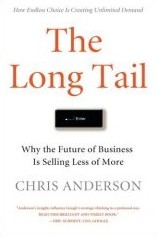 The 80/20-rule in marketing is history. In his book The Long Tail Chirs Anderson states that, in the internet age, 20 percent of the customers are no longer responsible for 80 percent of a company's turnover.
The 80/20-rule in marketing is history. In his book The Long Tail Chirs Anderson states that, in the internet age, 20 percent of the customers are no longer responsible for 80 percent of a company's turnover. Anderson argues that products that are in low demand or have low sales volume can collectively make up a market share that rivals or exceeds the relatively few current bestsellers and blockbusters, if the store or distribution channel is large enough. Examples of such mega-stores include the online retailer Amazon.com and the online video rental service Netflix.
Here you can find Anderson's blog, and more information about his book.
Read the column here.






4 comments:
For those of you who are dying to know where I get the radio emisions from the 70'ies I talked about in my previous column, well I'll share my well kept secret: here you go. You just have to send the guy an e-mail, and he will provide you access to the downloads.
Ik las uw column vandaag over de long tail in de krant en dacht, misschien gelijk even de volgende publicatie signaleren:
E-cultuur. Bouwstenen voor praktijk en beleid.
In de boekhandel, maar ook online.
http://www.vlaanderen.be/e-cultuur
Interesting:
AdAge recently titled an article on online ad spending 'The Short Tail'. They argue that Anderson's 'Long Tail' is practically non-existing. The top 10 companies online accounted for 72% of all interactive ad revenue last year, up from 71% in 2004. AdAge states TV's Big Four environment has turned into the Big Four online, with Google, Yahoo, MSN and AOL. (AdAge Nov. 27, 2006)
Yes, but also interesting in the same article: Google's AdSense product manager Gokul Rajarum cites that Google and its contemporaries used to account for even more of the online market share two years ago. Thus: the long tail appears to be growing longer.
Post a Comment